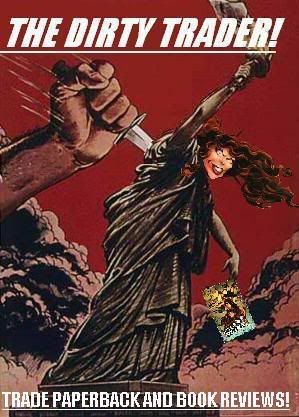I've sampled David Lapham's writing on and off since buying the first issue of Stray Bullets when it came out, but I didn't pay serious attention to him until the first collection of Young Liars blew me away. That volume was amazing, but I somehow got sidetracked after starting the second, and haven't even cracked open the third. The comic industry seems to have the same problem with Lapham, because they kept putting him on books with potential and the best of intentions only to see them canceled left and right. I'm not interested in a Deadpool book no matter who writes it, and then there's that nonexistent trade paperback collecting the short-lived Sparta: USA I'm still waiting on. Moving to Avatar seems to have suited Lapham, as he's been one of their most consistent performers, and he even managed to out atrocity Garth Ennis on Crossed from what I hear. Still, no projects quite spoke to me, and Avatar's pricing structure was prohibitive when it came to sampling. Finally, Ferals was announced, and I have a lifelong love of good werewolf stories (despite "good" and "werewolf stories" rarely finding their way into the same sentence.) Twenty bucks seemed reasonable for six issues, plus my new comic distributor offered vastly more favorable discounts on Avatar product than my old one. I was sold.
Ferals is a good bad comic. This is a book that's all plot and circumstance, while characterization is nearly absent, and every single character is detestable. The good news is that the story has a very cinematic quality in the best sense, with a density of information that is demonstrated visually rather than stated literally. By comparison, most "cinematic" comics are more like music videos; brisk shallow reads with (hopefully) a few money moments. Each chapter is meaty in the action department, and I don't just mean the sex and gory violence, but also the distance traveled by the narrative with each step. There's a lot going on to keep up your interest, and when the volume ends abruptly with a plethora of unanswered questions, you're left yearning for more. On the other hand, there's a massive weight on Lapham to explain all this shit, because the scenery and cast changes so frequently, the unfolding developments are all that exists to hook readers. Not to be a spoiler, but most of the characters introduced in the story are dead by the end of this volume, and you're unlikely to care about any of them, because everyone exists purely to service the plot.
Avatar has something of a gonzo house style between Mike Wolfer, Jacen Burrows, and Juan Jose Ryp. Artist Gabriel Andrade is more reminiscent of high end Vertigo artists like Darick Robertson, with classic clear storytelling enhanced by stylish flourishes. It very much suits the tale, which requires a grounding in reality so that the grisly details and inhumanity of the wolf is affective in contrast. It's a great looking book, well served by glossy stock and sound coloring. The subject matter goes far enough over the top to be too much for more skittish readers, but not as graphically lurid as much of the more infamous Avatar fare. Lapham is building a werewolf mythology not quite like any seen before, and I'm willing to give this title the benefit of any doubt based on the quality introduction found in this initial collection.




No comments:
Post a Comment